|
|
|
Sort Order |
|
|
|
Items / Page
|
|
|
|
|
|
|
| Srl | Item |
| 1 |
ID:
167092
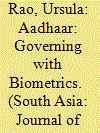

|
|
|
|
|
| Summary/Abstract |
Aadhaar means ‘foundation’ or ‘support’ in several Indian languages. Utter the word ‘aadhaar’ anywhere across the length and breadth of India today, and you will most certainly evoke India’s national biometric identification programme, the largest of its kind anywhere in the world. By the year 2019, the government had issued a twelve-digit unique ID to nearly every adult resident in India, linked to minimal biometric (fingerprints, iris scan data and facial photograph) and biographical (name, age, gender, address) information in a centralised database.
|
|
|
|
|
|
|
|
|
|
|
|
|
|
|
|
| 2 |
ID:
167091
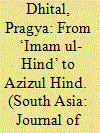

|
|
|
|
|
| Summary/Abstract |
This paper discusses the efforts of two Indian Muslim journalists, Abul Kalam Azad (1888–1958) and Aziz Burney (1952–), to use and overcome the constraints of direct and indirect censorship in order to address a community (qaum) conceived in their own image. It deals with these attempts through their responses to a series of national- and international-level crises, and to political groups that attempted to unite Hindus and Muslims. These include the nascent Khilafat movement, which was key to their coming together in the independence struggle and the Congress Party, and Congress’ ambiguous relationship with Muslims in the post-Independence period.
|
|
|
|
|
|
|
|
|
|
|
|
|
|
|
|
| 3 |
ID:
167095
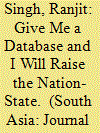

|
|
|
|
|
| Summary/Abstract |
This paper draws on an ethnographic study of Aadhaar, India’s biometrics-based national identification infrastructure, to investigate how members of its design team conceptualised and understood their techno-bureaucratic enterprise of assigning unique numbers to Indian residents. Members described their work using the metaphor of building an hour-glass: the Aadhaar number and its authentication services constitute the waist of this hour-glass; below were innovations in biometric devices and above were applications requiring identity verification services. They believed the entire ecosystem sustaining Aadhaar could be controlled by prescribing interactions between the waist and the components above and below. They extended this metaphor to reimagine the Indian government as a platform of services controlling only a specific part of a service—the waist—while opening space for innovation by integrating it with other market services above and below. This paper documents the emergence of this imaginary of ‘platformised’ government collecting real-time citizen data to support personalised state–citizen interactions to unpack how the future(s) of Indian government services shapes and is shaped by it. Such future(s) constitute the Indian population as a database, bureaucracies as centralised dashboards, and government as arbiter in the circulation of citizen data.
|
|
|
|
|
|
|
|
|
|
|
|
|
|
|
|
| 4 |
ID:
167096
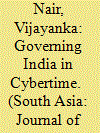

|
|
|
|
|
| Summary/Abstract |
Building on anthropological attention that has been devoted, appropriately, to the question of how states are spatialised, this article analyses how the swirl of discourse and everyday practice around India’s biometric identification programme serves to temporalise the state. The first half of the article examines how the Aadhaar initiative endeavours to assign the temporalising characteristics of innovativeness and expeditiousness to the contemporary Indian state. I show how mobility, change and speed are motivating factors for personnel at the Unique Identification Authority of India (UIDAI). In turn, I argue that Aadhaar is emblematic of the reimagination of the Indian state as a ‘start-up state’, or a lithe platform for innovation. I then explore the ways in which this start-up state is constructed in what one might call ‘cybertime’—a mode of imagining time that unsettles received understandings of historical time. In the second half of the article, I investigate how centralised efforts to temporalise the state are experienced by local implementers of Aadhaar as well as by its targets.
|
|
|
|
|
|
|
|
|
|
|
|
|
|
|
|
| 5 |
ID:
167105


|
|
|
|
|
| Summary/Abstract |
The essays in this special section demonstrate—in case anyone still believes otherwise—that the Aadhaar project is an exceptionally interesting problem for contemporary social science. Nandan Nilekani’s impossible programme of capturing proof of the names, births, addresses along with fingerprint and iris biometrics from over a billion people has revealed new features of the politics of networked technologies, of bureaucratic rationality, and of ordinary people’s strategies for dealing with both. The project has both changed globally-held perceptions of the possibilities for new forms of state capacity and confirmed the old, Arendtian view of bureaucracy’s capacity for banal evil.
|
|
|
|
|
|
|
|
|
|
|
|
|
|
|
|
| 6 |
ID:
167103


|
|
|
|
|
| Summary/Abstract |
This paper departs from the analytic lens of citizen versus the state and brings to attention intra-bureaucratic interactions in the wake of Aadhaar by focusing on the ongoing implementation of an Aadhaar Enabled Biometric Attendance System (AEBAS). Based on ethnographic research in a North Indian state, I show how AEBAS’ goals of performance evaluation and management were partially, and unintentionally, circumvented by staff members, in part owing to the socio-technical design of the system. I argue that an unintended consequence of projects using digital media technologies to quantify and manage performance is their tendency to produce a performance of management, and that scholars and activists must pay attention to such disjunctures inherent in projects of command and control.
|
|
|
|
|
|
|
|
|
|
|
|
|
|
|
|
| 7 |
ID:
167102
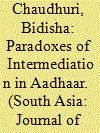

|
|
|
|
|
| Summary/Abstract |
E-governance projects in India are often purported to minimise the role of human intermediaries. They rely on machines to curtail corruption and bring more efficiency to service delivery. However, studies have found human intermediation and its affordances to be crucial, especially in developing countries where social endowment gaps pose considerable barriers to the effective use of information and communication technologies. Human intermediation in technological infrastructure is thus invisible yet inevitable. I unravel this paradox of intermediation by examining the everyday practices of two sets of intermediaries in Andhra Pradesh and Rajasthan associated with everyday workings of Aadhaar, India’s digital biometric identity infrastructure. Looking at biometric technologies as ‘situated practice’, I draw on the notion of ‘infrastructuring’ to argue that the discretionary practices of human intermediaries in fact stabilise the technological system, anchoring it to a human infrastructure. So, as disruptive technologies such as Aadhaar are implemented, their effective usage will invariably rely on the potential agency of human intermediaries and their collaborative work practices.
|
|
|
|
|
|
|
|
|
|
|
|
|
|
|
|
| 8 |
ID:
167097
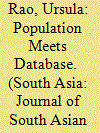

|
|
|
|
|
| Summary/Abstract |
This article traces the processes of making identities in digital India. By zooming into the two processes of enrolling in and using Aadhaar, it questions the distinction between identification and identity that pervades discussions of new technologies and shows that all Aadhaar-related procedures are productive of identity as a socially mediated process of creating or denying the condition for belonging. Following the introduction of Aadhaar, becoming a rights-bearing individual, for the most part, involves stitching together three types of identities: (1) a digital signature with (2) documentary proof of identity, both of which are based on (3) personal recognition. Aadhaar, then, does not change the ground on which official identity routines are built, but it alters the technical terrain people must navigate to become rights-bearing citizens. It adds a new layer of procedures on top of older techniques of recognition by insisting that persons must always be seen as unique individuals alongside being recognised as people holding a specific status.
|
|
|
|
|
|
|
|
|
|
|
|
|
|
|
|
| 9 |
ID:
167094
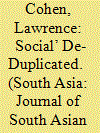

|
|
|
|
|
| Summary/Abstract |
India’s programme for biometric registration, Aadhaar, is organised through engineering concept work that depends upon three distinctive claims for the ‘social’ as human condition: (1) the social as ‘socialism’, the failed premise of Nehruvian decolonisation understood to have placed the poor into a condition of bare life; (2) the social-yet-to-come as the effect of a proper distribution of the good termed ‘service’, to bring the poor into a self-ameliorating form of life; and (3) the social as the affective entanglements that family, caste and religious ties of biography demand, ties that divert service from proper distribution. Within the concept-world of Aadhaar, such entanglements prevent the social-yet-to-come, demanding a form of government that can produce a political subject outside of biography, which for the engineers is achieved by conceiving of India as a database, an archive prone to the duplication of its elements, and thus governing India as one would govern a database: by continually ‘de-duplicating’ it.
|
|
|
|
|
|
|
|
|
|
|
|
|
|
|
|
| 10 |
ID:
167101
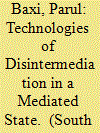

|
|
|
|
|
| Summary/Abstract |
The various lines of resistance against the Indian government’s Unique Identification Number project since its inception in 2009 form a national and publicly accessible narrative. But less is known about Aadhaar’s reception among civil society actors, non-profits who partnered with the state to implement this scheme among their constituencies. Drawing upon eighteen months of fieldwork in Mumbai, Ahmedabad and Delhi, this paper traces the nature of state and civil society engagement with Aadhaar. It demonstrates how this e-governance initiative encountered the politics and agendas of intermediary organisations long engaged in providing identity documents to the poor in the absence of state recognition of certain groups. The state sought a condition of disintermediation via biometric technology and collaborated with non-state actors to aid implementation. The failed encounter with a few non-profits working with the migrant poor demonstrates that a technocratic notion of identity and citizenship clashed with the materiality of local practices serving to maintain existing intermediations and resulting in exclusions from the Aadhaar scheme for certain groups. The paper argues that this encounter demonstrates the durability of the mediated state at a time when new technologies are deployed to remove intermediations, with consequences for the most marginalised populations.
|
|
|
|
|
|
|
|
|
|
|
|
|
|
|
|
| 11 |
ID:
167089
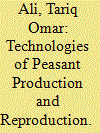

|
|
|
|
|
| Summary/Abstract |
In December 1959, the newly-constituted Pakistan Academy of Rural Development received permission to create a ‘laboratory’, that is, to conduct experiments in rural development upon peasants in Comilla, East Pakistan. This paper explores the enmeshing of post-colonial state formation and Cold War American development practices through an examination of how the Academy’s built environments, everyday practices and discourses were shaped by agricultural and contraceptive technologies. It examines how the Academy transformed a Gandhian ashram into a display and distribution centre for these technologies, and how technologies informed the Academy’s discourses on peasant religiosity and shaped peasant understandings of state and empire.
|
|
|
|
|
|
|
|
|
|
|
|
|
|
|
|
|
|
|
|
|